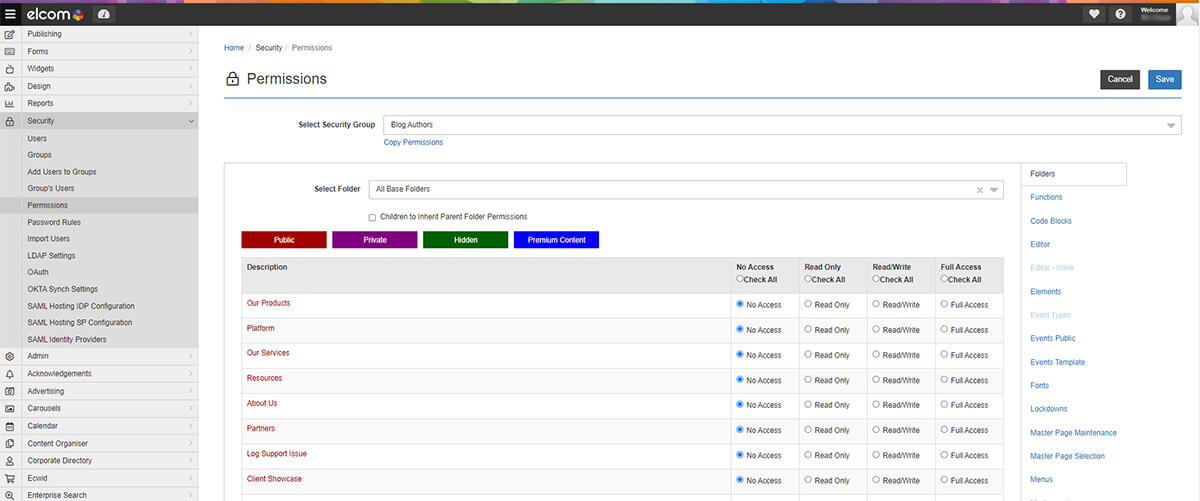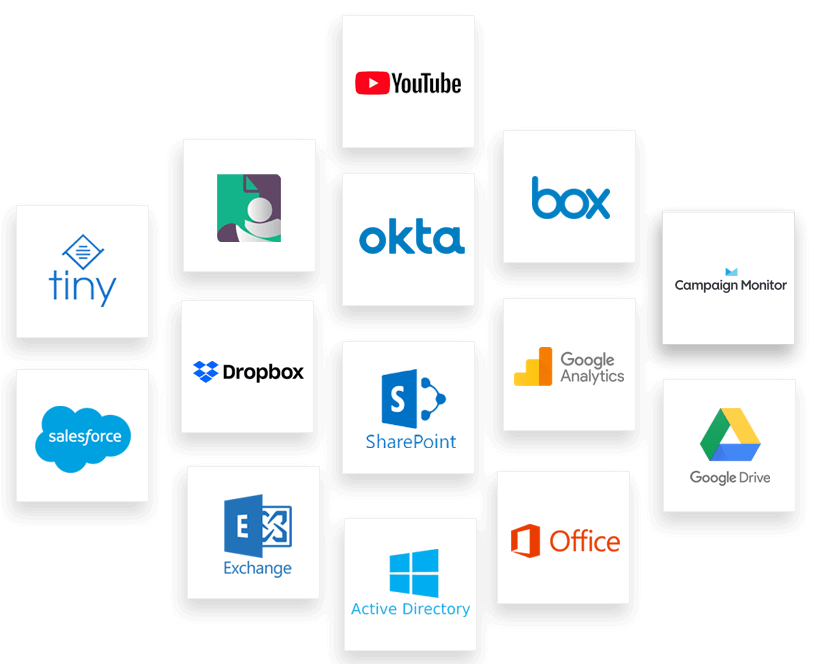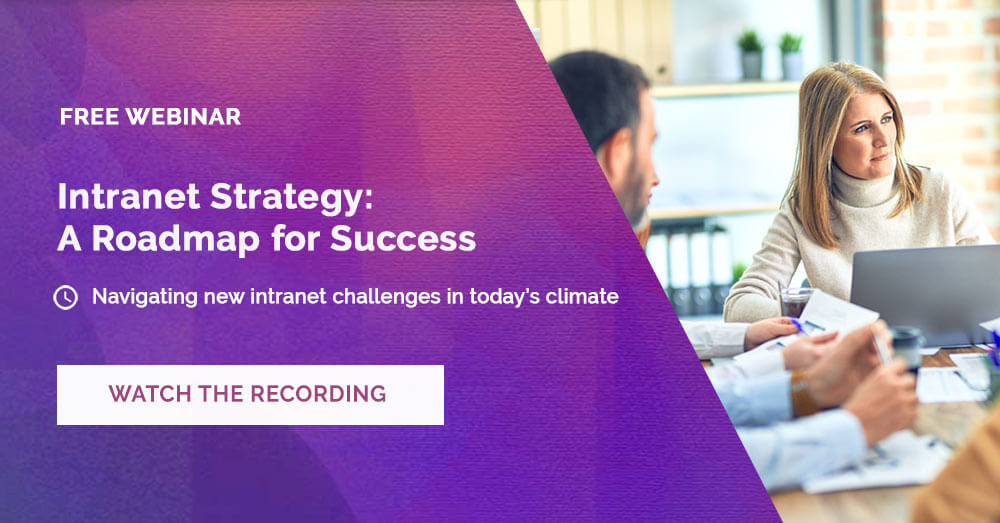Today, we're diving into a critical aspect of any digital workplace — secure intranet solutions.
In our interconnected digital landscape, the security and scalability of your intranet should never be taken lightly. As organisations continue to rely heavily on their intranet systems for internal communication, collaboration, and data management, the stakes have never been higher.
Implementing a scalable intranet is not just about accommodating growth, but also fortifying its security.
Breaches in security can lead to significant losses, both in terms of financial cost and the damage to an organisation's reputation.
By implementing strategic intranet security best practices, you can create a robust environment that stands strong against potential threats.
In this blog post, we'll delve into essential practices for strengthening your intranet security.
How to Improve Intranet Security
From understanding the nuances of on-premises security versus the cloud to implementing a comprehensive security policy, we'll walk you through practical tips and insights.
So, whether you're just beginning to set up your intranet or looking to enhance your existing intranet security measures, there's something in here for you.
1. On-premises Security vs The Cloud
One of the primary decisions that organisations face is whether to house their intranet solution on-premises or in the cloud. Each choice comes with its benefits and challenges.
For on-premises security, your IT department has direct control over the servers and security measures. This means that data remains within your physical location. Practical measures for maintaining on-premises security include regular updates of antivirus software, hardware and software firewalls, continuous monitoring for unusual activity, and regular system backups.
Cloud security, on the other hand, involves leveraging third-party providers. This reduces the hands-on work needed from your organisation, as the provider generally manages security. However, it's crucial to choose a provider with robust security measures and an excellent reputation.
Intranet Security Checklist and Recommendations:
- For the on-premises IT admin intranet security route, be prepared to invest in skilled IT personnel to manage these tasks efficiently.
- For the third- party provider route, ask potential providers about their security certifications, data encryption, intrusion detection systems, and disaster recovery plans.
- Whichever route you choose, ensure you have a robust disaster recovery plan. Regular audits and continuous monitoring of your security measures will help maintain a high level of security, whether you're on-premises or in the cloud.
2. Access Control / Security Groups
To minimise the risk of data breaches, it's essential to set up security groups and manage access controls. This means allowing only certain individuals or teams to access specific data or areas within your intranet.
Controlling who has access to specific data or areas within your intranet is essential in maintaining its security.

Intranet Security Checklist and Recommendations:
- Start by defining roles within your organisation and determining the level of access required for each role. The principle of least privilege (PoLP) is a good guideline, which means users should have just enough privileges to complete their tasks and no more.
- Consider grouping users with similar roles or access needs into security groups. It simplifies the management of access rights and ensures a uniform approach to data access. Ensure confidential information is only seen by the right people such as board members or senior management.
- Regular audits of access controls can help identify any misconfigurations or unnecessary access privileges.
- Choose an intranet solution that integrates with tools like Active Directory (AD) or Azure Active Directory, which can assist with managing access controls and security groups more efficiently.
- By carefully managing access control and security groups, you can ensure that only the right people have access to the right data, reducing the risk of internal breaches.
3. Identity Protocols
Identity protocols play a crucial role in enhancing your intranet security.
- Authentication: Identity protocols, like OpenID and SAML, verify a user's identity through credentials such as usernames and passwords. This process ensures that each user on the intranet is indeed who they claim to be, eliminating the risk of unauthorised access.
- Authorisation: After successful authentication, these protocols dictate what actions a user can perform based on their assigned roles and permissions. By controlling access to sensitive data and resources, organisations can minimise the risk of internal data breaches.
With identity protocols, user actions can be tracked and monitored, offering visibility into user behaviour. Such audit trails are vital for detecting any unusual or potentially harmful activity.
They ensure only the correct individuals have access to your data, providing an extra layer of security.
Intranet Security Checklist and Recommendations:
- Enable multi-factor authentication (MFA) for your intranet. Enable Multi-Factor Authentication (MFA): MFA adds an extra layer of security by requiring users to provide at least two forms of identification before gaining access.
- Adopt Single Sign-On (SSO): SSO allows users to access multiple applications with one set of login credentials. It simplifies user experience while ensuring robust identity verification.
- Regular Auditing: Conduct regular audits of your identity protocols to identify and address any potential vulnerabilities.
- User Education: Ensure your users understand the importance of these protocols. Regular training sessions can help users avoid common mistakes and understand the role they play in security.
- Password Management: Implement strong password policies. Encourage or enforce the use of unique, complex passwords and frequent changes.
4. Secure Third-Party Integrations

Third-party integrations can enhance your intranet capabilities. However, they may also pose potential security risks.
Therefore, it's vital to ensure any integrations you use come from trusted sources and have robust security measures in place.
Intranet Security Checklist and Recommendations:
- Begin by choosing integrations from reputable vendors that have a track record for strong security measures. Before integrating, evaluate the vendor's security practices and history of dealing with vulnerabilities.
- Next, always adhere to the principle of least privilege when granting access rights to third-party applications. The applications should only be granted permissions necessary to their function.
- Regularly monitor and update these integrations, keeping an eye out for any changes in their security protocols or reported vulnerabilities. Consider using a security gateway to control and monitor data exchanged with third-party apps.
5. Keeping Your Platform Updated
Often, organisations choose to update their intranet platform to access the new features or enhancements to existing functionalities, as well as to get the latest software updates that come with improvements in the efficiency and reliability of the system.

But updating your platform also comes with the benefit of keeping you safe from potential vulnerabilities!
Software updates often include patches for security vulnerabilities that have been discovered since the last version was released. Cybercriminals are always on the lookout for systems running outdated software, which they can exploit to gain unauthorised access.
Maintaining an up-to-date intranet platform is critical in keeping it secure. Outdated software often becomes a target for cybercriminals looking to exploit known vulnerabilities.
Intranet Security Checklist and Recommendations:
- Develop a regular schedule for updates and stick to it. If your platform supports it, enable automatic updates to ensure you're always using the latest version. Regularly check for any patches or updates released by the software provider, as these often include security enhancements. Consider implementing an intranet-in-a-box solution that will notify you of security updates.
- Also, when planning updates, don't overlook any plugins or third-party integrations. These also need to be kept up-to-date to maintain a secure intranet environment.
6. Establish a Comprehensive Security Policy
A comprehensive security policy should outline protocols for everyday intranet security practices, response plans for potential breaches, and rules for data handling and storage.
Intranet Security Checklist and Recommendations:
- Choose a secure intranet provider that can clearly articulate their security policy.
- Have an existing intranet system? Start by identifying potential risks and vulnerabilities in your intranet environment.
- Promote a security-first culture within your organisation by making the policy accessible to all employees.
- Regular training sessions can help ensure everyone understands and adheres to it. Enterprise intranet security measures are particularly important for organisations with a large and diverse workforce of people working from home and across different locations. The policy should also be enforced uniformly across all levels of the organisation to promote compliance.
- Regularly review and update your security policy to address any new threats or changes in the digital landscape. Involve all stakeholders in this process to ensure a broad perspective on potential risks and safeguards.
7. Encrypt Data (Even in a Private Network)
It's a common misperception that private networks are immune to security threats. The reality is, even within a private network, data travels through several points, making it vulnerable to interception or alteration.
Private networks, though more secure than public ones due to controlled access, are not invincible. Internal threats, intentional or accidental, pose a risk, with human error being a common cause of data breaches. Moreover, these networks aren't isolated; they often connect with other networks or the internet, leaving potential entry points for cyber-attacks.
In the current digital era, where vast amounts of data are shared and stored, encryption's importance is only magnifying. The cost of data breaches is not only financial but also includes reputational damage and loss of trust.
Encryption comes to the rescue here. It transforms data into an unreadable format, or cipher text, during storage or transmission. Only those with the correct decryption key can revert this cipher text to its original format. This means even if data is intercepted, without the decryption key, it remains a nonsensical combination of symbols, numbers, and letters, ensuring the data's safety.
Intranet Security Checklist and Recommendations:
- Start by choosing robust encryption standards like AES-256 for your data. Implement end-to-end encryption to ensure that data remains secure throughout its journey, even within your private network.
- Consider employing a virtual private network (VPN) for an extra layer of security. A VPN ensures that even if your network is compromised, the data remains encrypted and, therefore, secure.
- Ensure your encryption keys are securely managed. Use a secure key management system and regularly rotate encryption keys to add another level of protection to your data.
- Regularly review your encryption methods to ensure they're up-to-date and in line with current best practices.
Conclusion
Navigating the complex world of intranet security can seem daunting, but with a proactive approach and consistent vigilance, you can significantly enhance the protection of your digital workplace.
By understanding the key differences between on-premises and cloud security, managing access controls effectively, securing third-party integrations, keeping your platform updated, establishing a comprehensive security policy, and implementing encryption even on private networks, you're well on your way to safeguarding your intranet environment.
Remember, strengthening intranet security isn't a one-time setup; it requires constant monitoring and regular updates to stay ahead of emerging threats. It is one of the many intranet best practices we recommend. The cost of maintaining robust intranet security pales in comparison to the potential losses that can result from a security breach.
At Elcom, we're committed to supporting you in your journey to delivering an engaging and secure intranet solution. Chat to your team today about the robust intranet security best practices we’ve put in place.
Your intranet is the heart of your organisation's digital communication - keep it safe and it will serve you well for many years to come.
If you’re looking for more insights check out our guide on successful intranet launches or our webinar on Intranet Strategy: A Roadmap to Success.
